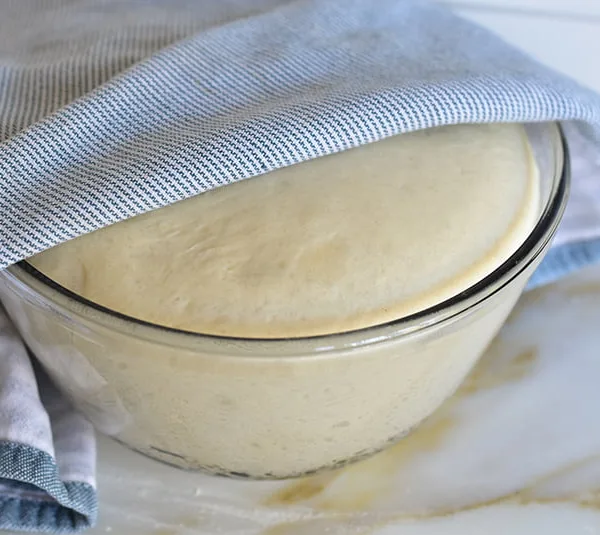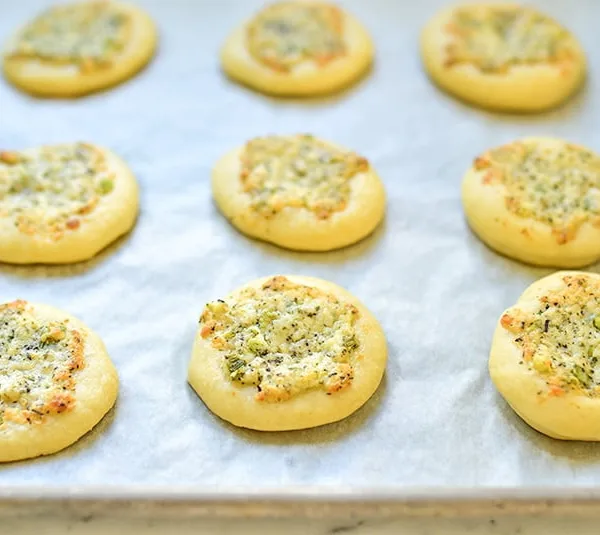This post may contain affiliate links. Please read our disclosure policy.
Koosa Fatayer are one of many Lebanese fatayer recipes, little triangular pies with savory fillings. Practice makes perfect in getting the dough pinched very hard along the seams to keep the pies from opening up.

When one makes a study of literature, as I did in college and graduate school, there are phrases from all of that reading that stick with you. I’m glad for this, and so glad that all has not been lost to the years (lots of them).
One of my old favorites: Ezra Pound’s “make it new.”
The times when I’m feverishly, excitedly in the kitchen discovering how a Lebanese ingredient might be used in a new way (za’atar kale chips!, pomegranate rose sorbet!), Ezra’s mantra hovers there with me. Make it new, Mo….

I get just as excited when I experience the make-it-new factor anywhere, especially when it comes to Lebanese flavors. The brussels sprouts with dates and walnuts that we had out in California: wowza. The za’atar filled croissant that sent my head for a spin in Beirut. Little tiny kibbeh bites with tahini sauce. (I haven’t shared those with you yet? Stay tuned!!)
A similar discover took place when I was out on the road for the Library of Michigan book tour this spring, I headed to the west side of the state, with a detour through Grand Rapids. I’d heard about an epicurean shop there owned by a Lebanese family, with major wine distribution. Mom, Peg and I thought we’d stop in and see about it.
We had wine on the brain, but found a dazzling array of goodness. This is serious, I said. This is Chicago-level, Peg said. Chocolate! Mom said (the wall of chocolate bars was out of control!).


As I wandered down the aisles to the opposite end of the shop, I discovered a whole other project going on: a gorgeous pizza oven for pizzas to go, and a deli counter whose contents revealed that yes, this place is owned by Lebanese: arras kibbeh, tabbouleh, baba and hummus.
And fatayar–but with fillings I had never seen before or thought of: Sesame with pine nuts and cheese. Koosa with onion and sumac. They even dusted the tops of their fatayar with a hint of what’s inside, such a pretty idea.
Not long ago I was leafing through my Lebanese cookbooks and saw, lo and behold, the koosa fatayer with sumac. A very traditional savory summer pie!



When I told Dan about all of this, he noted that he’s glad I’m open to learning new things from tradition, just like when he told me about za’atar.
Wait. What?
Yeah, you hadn’t heard of za’atar before we met. And you hadn’t rolled grapeleaves before either.
Okay. Those are fighting words.
I had to pull out the photos. There’s proof, bro, if you need it. Doesn’t my young face just reach out into the future and say Here Dan, I’m making grape leaves with Aunt Hilda!

And just for his Lebanese I-know-more-than-you attitude, I told him I’d be making those koosa fatayer asap, and they’d all be koosa. He and I both know that’s a particular jab, since he really isn’t getting excited unless his fatayer have meat in them.
I wasn’t even sure I’d let him have a taste after all of that.

But who can take the scent of fatayer baking and not stand by the oven waiting for them to come out? You know he did more than taste…he ate, and ate some more, directly out of the oven.
Delicious, he said. Never had koosa fatayer before.
Great idea you had, I said. Thanks for sharing it with me.
Welcome, he said.

More Fatayer Recipes
Lebanese Spinach Pies, Fatayer Recipe
Lebanese Meat Pies, Fatayer Recipe

Koosa Fatayer Recipe
Ingredients
For the dough:
- 1 tablespoon active dry yeast
- 1 teaspoon granulated sugar
- 1 cup warm water (about 105 degrees)
- 3 cups unbleached, all-purpose flour
- 1 teaspoon kosher salt
- 1/3 cup canola or other neutral oil (such as safflower), plus more to coat the pans
- 2-3 tablespoons extra virgin olive oil, to coat the fatayar before baking
For the filling:
- 3 cups grated zucchini or koosa (about 3 medium zucchini, on a large-hole grater)
- Big pinch Pinch kosher salt, plus one teaspoon for seasoning if the sumac doesn’t contain salt
- 1 medium yellow onion, finely diced
- 1 tablespoon sumac, plus more for garnish
- Few grinds black pepper
- Juice 1/2 lemon
Instructions
- Proof the yeast by dissolving it in ¼ cup of the warm water with the sugar and letting it activate for about 10 minutes, or until creamy and starting to bubble.
- Whisk together the flour and salt in a mixer bowl or medium bowl. Create a well in the center and add the oil and proofed yeast mixture. Using a stand mixer fitted with the hook attachment (ideal because this is a wet dough) or by hand, slowly work the wet ingredients into the dry, adding the remaining ¾ cup of water slowly. Add more water only as necessary to create a sticky dough.
- Knead by hand or with the dough hook in the mixer until the dough is very soft, smooth, and tacky/sticky to the touch (but it should not leave dough on your fingers when touched). The kneading by hand can be awkward at first because it’s such a wet mess, but as you knead, the dough will firm up a bit and absorb all of the water.
- In a clean bowl at least twice the size of the dough, lightly coat the dough and the sides of the bowl with oil. Cover with plastic wrap and let rise in a warm spot until doubled, about 90 minutes.
- While the dough rises, drain the grated zucchini with a pinch of salt in a colander in the sink.
- When the dough is ready (90 minutes), squeeze the zucchini to remove as much liquid as possible. Combine the zucchini with the onion, sumac, pepper, and lemon. Taste and adjust the seasonings if needed.
- Preheat the oven to 375 degrees. Brush two heavy baking sheets with canola oil (I line them with nonstick foil and brush that with oil; this is optional).
- Roll half of the dough out on a dry work surface to ⅛-inch thickness. Gently lift the dough from the edges to allow for contraction. Cut dough into 3- or 4-inch rounds. Knead together the scraps, cover with plastic, and set aside.
- Fill the rounds of dough by placing a heaping tablespoon of filling in the center of each round. Be careful not to let the filling touch the edges of the dough where it will be gathered together and closed. A good way to keep the filling in the center is to lower the spoon with the filling over the center of the dough (parallel to it) and use your fingers to slide the filling off the spoon and into the center of the dough circle.
- Bring three sides of the dough together in the center over the filling and pinch into a triangle. Close the dough firmly.
- Place the fatayar on the baking sheets and generously brush or spray the dough with olive oil. Bake in the middle of the oven for 18-20 minutes, or until golden brown. Set the oven on convection bake for the last 5 minutes of baking to encourage browning. Remove them from the oven, brush with a touch of olive oil, and dust very lightly with sumac immediately.
- Repeat the process with the other half of the dough, then with the scraps that have been kneaded together and left to rest for a few minutes before rolling out.
Nutrition information is automatically calculated, so should only be used as an approximation.











ATTENDED YOUR DEMONSTRATION IN CHGO 2YRS AGO AND WAS DELIGHTED WITH YOUR RECEIPES NEW AND EASY..DELICIOUS…..DOROTHY
Hi Dorothy! Thanks so much–great to connect with you here!
Thanks Maureen!
I am always looking for original recipes for my son who is a fanatic vegan.
But…..Sumac? can be replaced? I don´t think I can find that here in Spain.
Yum! I never would have thought zucchini pies could look so delicious. I can almost taste them through the screen… 🙂
Hi Maureen,
I love spinach fatayer so much, but will have to give these a try!
I wonder if you have any Mexican markets nearby? There is a squash called Calabacita. It’s sold locally here in the west (Colorado) at the farmer’s markets and local Mexican markets and it very much resembles Lebanese Koosa – light green and speckled. Do an online search and you’ll see what they look like.
Maureen,
I just finished making the Koosa Fatayar and they are delicious. I actually added a little za’atar to the filling to add a lilttle more zest. Thank you for all your wonderful recipes. I am a first generation Palestinian American and while I grew up eating all of these wonderful foods, I never attempted to make any until your stories inspired me to try. Still having a little trouble getting the triangle shape perfected, but I guess that means I will just have to keep making them. Thank you!
Shoot! I wish I had known you were going to be in GR, that’s where I live! I also live right down the street from Martha’s Vineyard and it is one of my absolute favorite places to go! So glad you got to try it. Thanks for all the great recipes, this one will definitely be tried sometime soon. I always love savory pies, these look great!
koosa fatayar?
wait. what?
that sure doesn’t look like lebanese koosa.
it looks more like zucchini to me. hmm-mm
Haha!! No Lebanese koosa here . . . but the zucchini is so much more widely available and just as delicious!
I love your articles. I am full blooded Lebanese from Boston. I moved to Chicago 50 yrs ago after getting married. I married a Slovak who loved kibbee, meat pies and anything with meat my children and grandkids love Lebanese cooking. Nothing like our food
Thank you again for the delicious receipes. I have no Lebanese friends in the area.
Hi Maureen,
I attended your wonderful presentation in Grand Rapids and have been making recipes from your cookbook ever since-best grape leaves I’ve had. I’ve been peeling my chick peas for hummus ever since a trip to the middle east where I fell in love with the “buttercream” hummus you describe, so happy to hear you endorse this step! Can you share the name of the family owned Lebanese food shop you visited? Thanks for so much inspiration!
Ann, hello and thank you! Yes, the shop is Martha’s Vineyard. You will love it! And I am so happy to hear about your grape leaves and hummus!